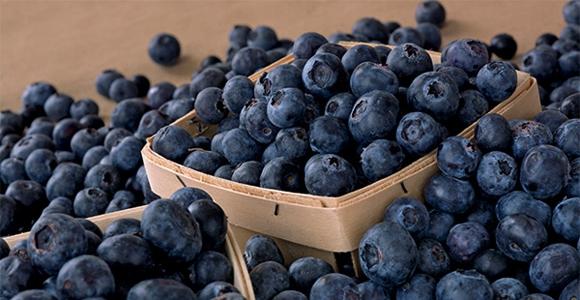Blueberries usually are propagated from softwood or hardwood cuttings by cutting selected twigs from healthy, disease-free mother plants. Cuttings are placed in propagation beds in a medium that holds moisture well but also allows adequate aeration.
Softwood Cuttings – Take softwood cuttings (4 inches to 5 inches long) in late spring from the tips of the current season’s growth. Collect these cuttings when stems have developed woody tissue but are still somewhat flexible and terminal leaves are half-grown to almost mature. Cuttings taken too early (terminal leaves very succulent, stems very flexible) may readily wilt. Cuttings taken too late (mature leaves, second flush of growth initiated), may poorly root. Rooting usually is more successful when cuttings are taken from the first flush of spring growth. However, cuttings can be collected from growth flushes occurring later in the growing season.
Take cuttings from the upper part of the mother plant. Use sharp, clean pruning shears or knives disinfected in a solution of 1 part household bleach to 5 parts water. Remove lower leaves leaving two or three terminal leaves. Don’t allow cuttings to dry; keep them moist and cool after collection. Place cuttings in the propagation bed, under mist, as soon as possible at a depth of one-half to two-thirds of their length.
Hardwood Cuttings – Hardwood cuttings are taken during the dormant season after sufficient chilling has occurred, usually late January through February. Collect strong, healthy shoots or “whips” (usually 12 inches to 36 inches long) that grew the previous summer. Divide these “whips” into sections 5 inches to 6 inches long with a sharp knife or a bench saw with a fine blade. If the terminal of the shoot contains flower buds, remove the flower buds or discard the tip.
Insert cuttings into the propagation medium from one-half to two-thirds of their length with one shoot bud exposed. Keep the propagation beds moist, but be careful not to use too much water. Water hardwood cuttings with a sprinkler until they start growing leaves, then mist-water the cuttings until they are rooted.
After cuttings are rooted, apply a dilute complete liquid fertilizer weekly. Plants can remain in the propagation bed until winter, when they should be transplanted into pots or nursery beds and held them for one year. The plants should be large enough for field planting the next winter.
Propagation beds need to be well-drained, under shade cloth (40 percent to 70 percent shade), and have adequate ventilation. Avoid excessive wind movement that may interfere with mist control.
Propagation Media – A medium that retains moisture well but allows aeration is necessary. Media containing various propagation mixtures of coarse sand, ground pine bark, perlite, sawdust, and peat moss have proven satisfactory. A good rooting medium recipe is a mixtures of coarse sand, ground pine bark, and peat moss (1:1:1) or perlite and peat moss (1:1).
Mist System – The mist system should keep the media uniformly moist but not soggy. If only a few drops of water can be squeezed from a handful of media, the amount of moisture is probably correct. An intermittent-mist system is needed to keep the humidity around the cutting near 100 percent, preventing wilting, and keep the medium moist. Starting with a porous medium that holds moisture well, adjust the mist intervals to maintain turgid (non-wilted) leaves and high humidity. Frequent (2 minutes to 10 minutes) short misting intervals (2 seconds to 10 seconds) are recommended.
Important Considerations One of the major problems with collecting propagation wood from other grower’s fields is contamination of cutting wood, either with off-type cultivars or with diseases. Many farms have a small percentage of off-type cultivars mixed with their primary cultivars. This can create serious problems at harvest time if the off-type ripens at a different time than the primary cultivar. The off-type cultivar may also be of lower quality than the primary cultivar, and thus lower the grade of the packed fruit. When available, always purchase virus-tested, true-to-type plants to serve as propagation sources.
Diseases such as viruses may be transmitted via cutting wood taken from infected bushes. Although distribution of blueberry viruses appears to be limited at this time in the Southeastern United States, avoid propagation from plants that have odd-looking or stunted foliage. They may be harboring a virus that could reduce yields. The Blueberry Stunt phytoplasma is common in North Carolina, and can be transmitted via propagation. Stem Canker is a fungal disease causing swollen cankers that eventually kill infected canes. Avoid collecting cutting wood from infected plants.
Avoiding off-type or diseased cuttings during propagation is best accomplished by scouting the source field during the growing season prior to taking cuttings. Specific rows or individual bushes of uniform, healthy source plants can be most easily found and mapped during bloom and harvest, excluding visibly diseased or off-type bushes. This pre-propagation scouting is especially necessary when growers are planning to take dormant, hardwood cuttings, since off-type or diseased bushes may not be easily identifiable in winter. Once your own field is established, you will be able to identify and remove offtype bushes over time and avoid contamination of your propagation material.
References:
- Braswell, John H. Establishment and Maintenance of Blueberries. Retrieved 14 June 2010.
- Krewer, Gerard and Bill Cline. Bluberry Propagation Suggestions. Retrieved 16 June 2010.
Return to Blueberry Production articles.
